How to make a drywall arch?
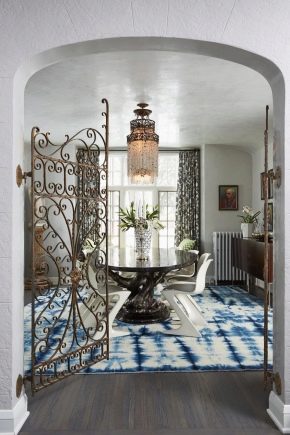
Arches are the oldest architectural element. They were actively used even in the first states of the Ancient East. Arched architecture was extremely popular in ancient Rome, both in exteriors and interiors. In modern design, arched structures are experiencing a "rebirth". They are increasingly used not only in expensive apartments, but also in ordinary apartments.

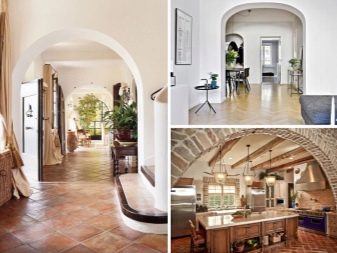
Such popularity of arches is associated with their practicality and decorativeness at the same time.
What is it for?
Typically, vaults in apartments and other living spaces are used instead of doors. In an apartment in a frame house, such structures will look especially advantageous, since this construction technology provides for lightness, the absence of massive partitions (doors) and air saturation of the premises.

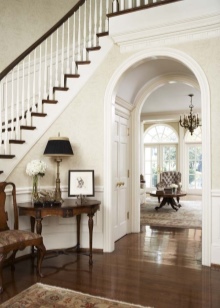
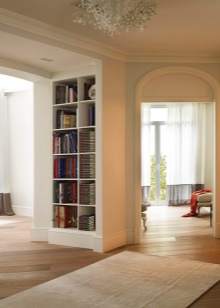
Although some spaces are initially designed for an arched element, often the idea of using such an overlap is born much later - then arches are used to replace the doors already in the interior.
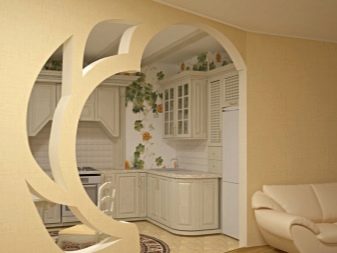

The use of vaulted ceilings allows you to solve several problems at once:
- Expansion of space. Arches allow you to make the room visually more open. In addition, they provide very real space savings, since doors, both in closed and open states, not only limit viewing angles, but also take up physical space that can be used for other purposes. Interior arches allow you to achieve significant space savings, especially in small apartments.
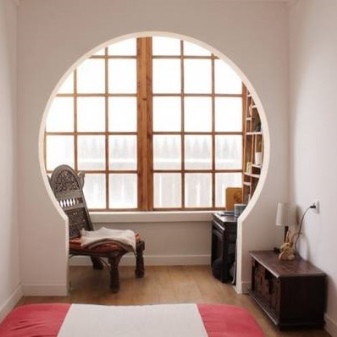
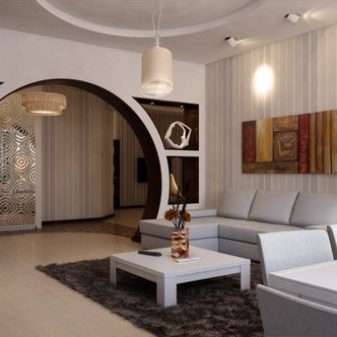
- Decorativeness. Doors, of course, can also be beautiful, but they still cannot compare with arched structures in the wall, especially in terms of the ratio of aesthetics and geometric diversity. Vaults can have various floors and shapes, from classic to ultra-technological.
- Additional functionality. Vaulted elements can also be used in rooms where doors or similar structures are generally inapplicable. For example, in long corridors, which, with the help of arches, can be divided into diverse interiors, making them more expressive and stylish. Such ceilings are an excellent solution not only in the hallway, but also for the kitchen - it often makes no sense to make the entrance to it isolated. Extra partitions, especially in small apartments, in such a case will only interfere.
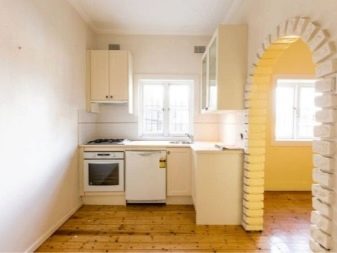
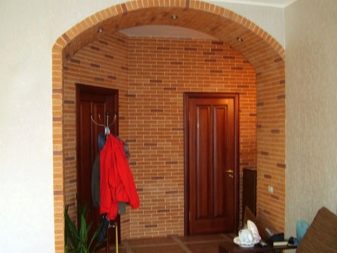
With all the advantages, the vaults have very few disadvantages, and even those are very subjective or are among the prejudices. For example, there is a widespread myth that redeveloping an apartment under arches can destroy the balance of load-bearing structures. In fact, ceilings, as a rule, do not affect the reliability of load-bearing walls, and such redevelopment is absolutely safe.
Another more objective drawback is the impossibility in any way (without redevelopment) to block the arch in order to create an absolutely isolated room. In theory, different draperies or curtains can be used, but this will not solve the problem of soundproofing. Thus, arches are unlikely to be suitable for connoisseurs of silence and solitude and can significantly limit the personal space of residents. However, if necessary, you can always return to the classic doors.
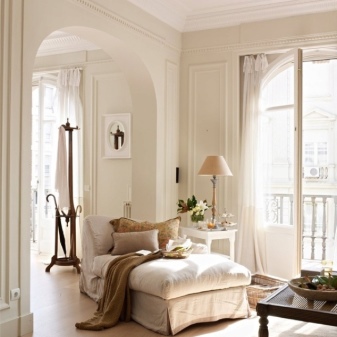
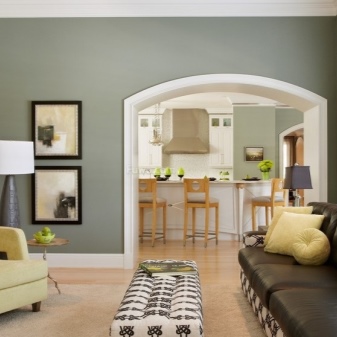
And one more important point.Open floors are good, but not always and everywhere. The main criterion that determines the appropriateness of their use is the height of the opening. Ideally, it should be at least two meters, better - 2.5 m and above.
Otherwise, instead of expanding the space, the vault will limit it.

Views
The vaults are of various types. Each of them is suitable for a certain style, type of interior. The main criterion for differences is the form, which, in turn, affects the complexity of manufacturing, determines the strength of the effect of expanding the space and, in general, forms the geometric rhythm of the interior. The main types of floors are as follows.
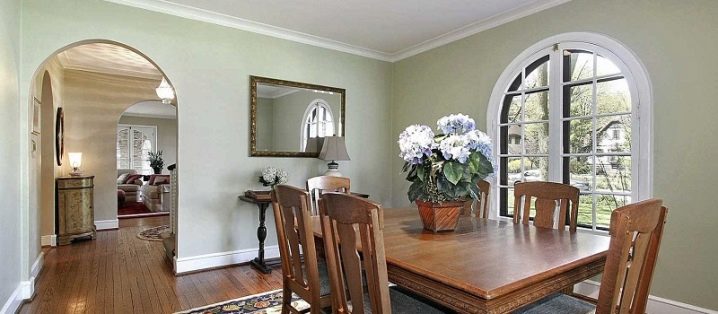
Classic version
The vaults are symmetrical, have a semicircular dome shape and, as a rule, have a constant radius. One way or another, in shape they beat a semicircle, a part of a circle (up to half). This is the most common option. The use of such arches visually expands the space, saturates the room with air and adds a classic decorative effect to the interior.
It is also a very versatile choice, because with a competent approach, such overlaps can "play" in modern surroundings, be it high-tech or others. They do not always harmonize with the loft, they require serious revision when decorating in the colonial style.
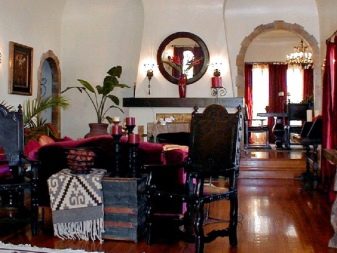
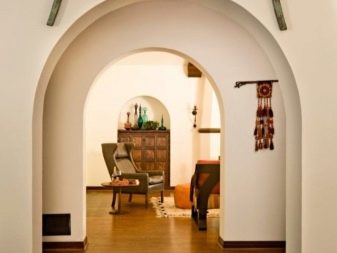
Modern
The side surfaces of such slabs are longer, respectively, the radius of the circular arc is smaller. This creates a sense of slimness and sophistication. Let's not forget that modernity as a style implies, on the one hand, a return to the ideals of the classics, and on the other, a striving for new forms.
The arches are very elegant, however, they require a sufficient room height (preferably slightly more than the average required, which was mentioned above). Modern ceilings require increased attention to the decor of the side surfaces.
Suitable for both classic and modern styles, including a loft, but the interior must match.

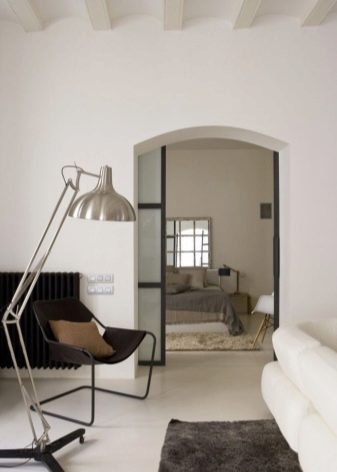
In some cases, it is not recommended to use too heavy furniture, dark color combinations with such arches, however, the airiness should not "roll over" - it is desirable that some of the interior objects seem to balance the upward direction of the vaulted structure.
Close to modern and elliptical forms - a cross between classic and modern (in terms of the length of the side surfaces). It is a less aesthetically radical style with a touch of sophistication and sophistication.
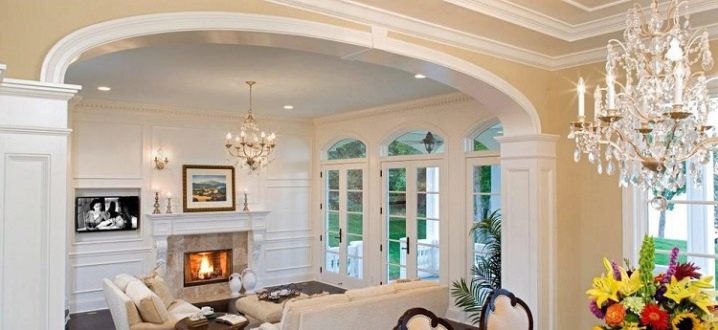
Portals
Rectangular or even square openings. Often, however, there is confusion in terminology, since all arches are understood as "portals". Within the framework of this article, we will consider "portals" as structures with right angles.
Historically, portals have the most intense ornamental flavor. Their task is not only to expand the space, but also to emphasize the monumentality of the entrance, to make it majestic. Portals were often used as entrances to government or religious institutions and consisted of several repeatable (to enhance effects) overlap elements.
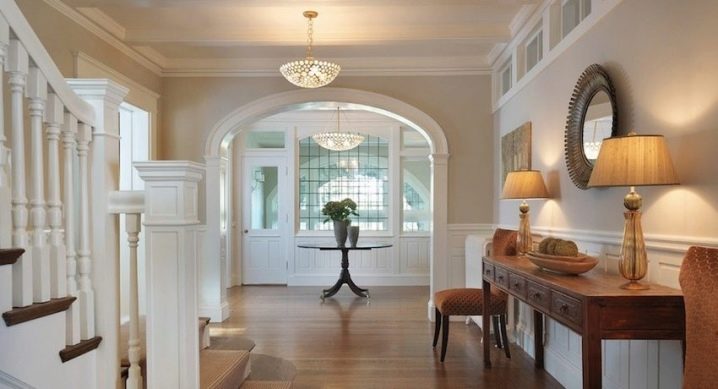
In modern interiors, portals, unlike many other arches, are the closest in nature to ordinary doors, which makes it difficult for designers to work in relation to revealing the main advantages of the vault in the room.
It is better to pay special attention to the style when making a drywall portal on your own, because there is a risk that, of course, there will be no doors in the room, but the portal as such will not work - only a feeling of eternal repair and incompleteness will remain. Ornamentation and moderate decor can help. Often used in conjunction with sliding doors.
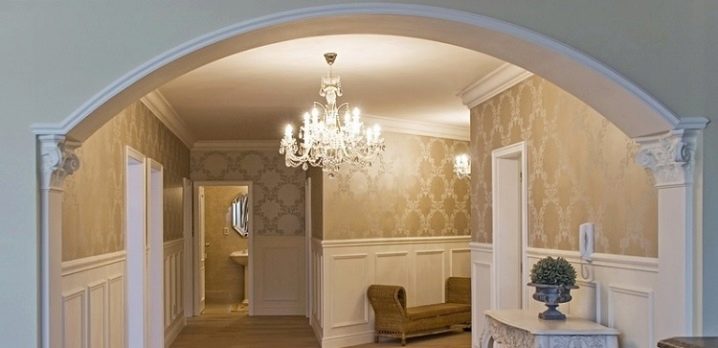
Trapezoid
Has the shape of this geometric figure. A cross between a portal and classic arched arches. An interesting shape can emphasize constructivist ideas in the interior.Suitable for a loft, other modern styles, it will look unusual (but curious) in classic interiors.
Not as common as previous options. There is no special designer fashion on the trapezoid now, so its use can emphasize the original tastes of the owner. Somewhat more difficult to manufacture than previous types.

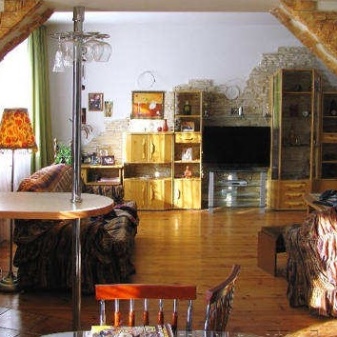
Gothic
The arch has its highest point - it is a bright attributive element. Although such a vault is capable of evoking various medieval associations with cathedrals and other religious buildings, it is now a very distinctive element of the interior. You can rarely meet, it is suitable for stylizations under the classics, baroque, even rococo. Sometimes it is used in creative studios that promote artistic culture.
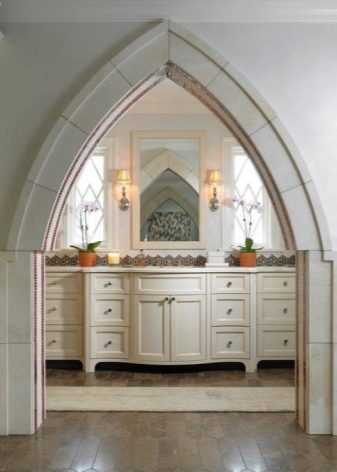

Creates a feeling of striving upward, but at the same time and creative emancipation. When decorating and decorating in light colors, there is also a sense of artificiality and playfulness.
In small rooms, Gothic is difficult to take as seriously as possible - hence another area of application - children's rooms.
Fishnet
They imply the decorative saturation of the side surfaces, which can have various openings in the form of geometric shapes. These are very wide shapes that fit well into large interiors. Adds a sense of space - a good option for richly styled contemporary styles, including hi-tech.
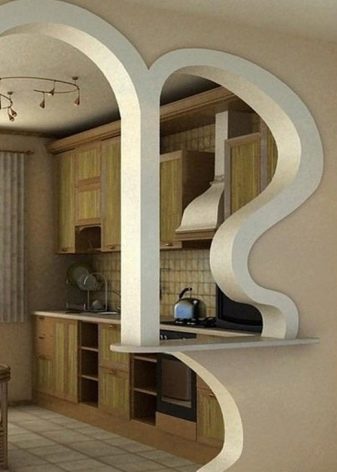
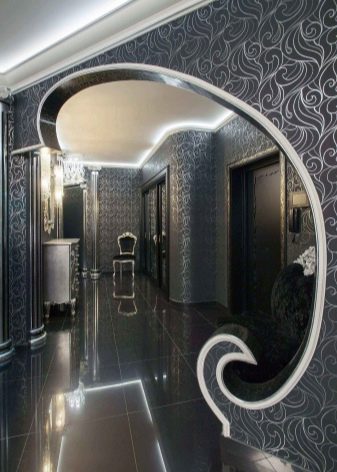
Half-arch
The most economical option in terms of material costs. In fact, this is half of the usual classic arch in a slightly elongated (stretched) design. Maybe openwork. Semi-arches are suitable for almost all interiors, especially modern ones - loft, minimalism, hi-tech, as well as modern. Will fit well into small apartments.
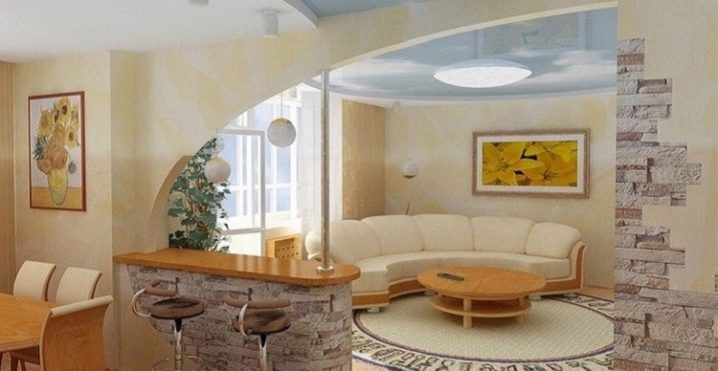
Multilevel
These are already design delights. They can consist of several floor surfaces, each of which has its own shape and height. This is a radically modern option, suitable for large premises and unique decor. In other living conditions, it will look strange, if not just comical.
Multilevel arches are often decorated in light, bright colors using a large number of colors in the palette. Certainly not suitable for classic interiors.
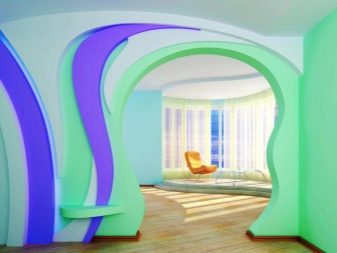
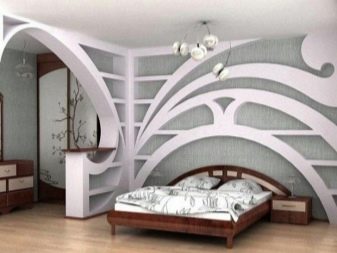
We add that the choice of a suitable type of vault should be based on a number of basic criteria, namely, the footage of the room, preferences in terms of styles and colors, as well as technical skills and capabilities (in case of self-production).
Instruments
To make a vault yourself, you will need not only skills, but also the appropriate tools and materials. Let's name the main ones, without which you shouldn't start.
First of all, these are measuring instruments - rulers, tape measures and others. You cannot do without a working tool - knives and scissors, self-tapping screws (preferably for metal), a drill, a screwdriver, a hammer, nails, dowels.
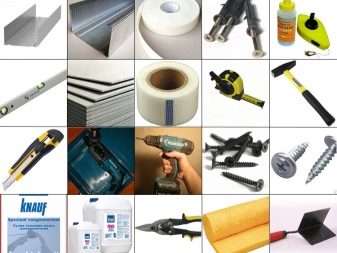
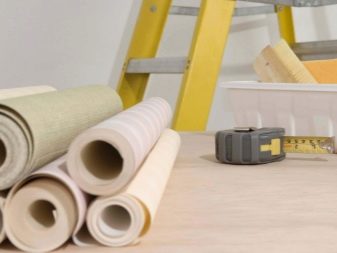
Among the main materials, in addition to drywall, you will need a primer, a perforated corner (to improve the extreme parts of the structure), paints, wallpaper, putty.
Do not forget also about glue, work gloves and other basic technical equipment that may come in handy at work.
Material features
Drywall is the most suitable material for creating vaulted compositions at home, especially if you do it yourself. It is common, relatively inexpensive and durable.
The structure of drywall is three-layer: two layers of cardboard and a core made of dense gypsum mix with various additional ingredients. More than 90% of the mass is just gypsum.

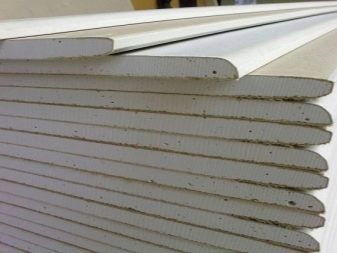
You can buy drywall in various versions. The most common shapes are from 2000 to 3000 mm by 1200 mm.
The material is quite soft and plastic, so that it will not be difficult to cut out forms suitable for a particular door structure from these sheets.
We add that drywall is a fairly environmentally friendly and safe material. Nevertheless, it is also very technologically advanced. The history of the appearance of drywall is associated with the papermaking business in the United States of the 19th century. Then there were about 10 layers of paper in it, covering a thin layer of gypsum. The patent of close to modern drywall belongs to the American engineer Clarence Utsman.
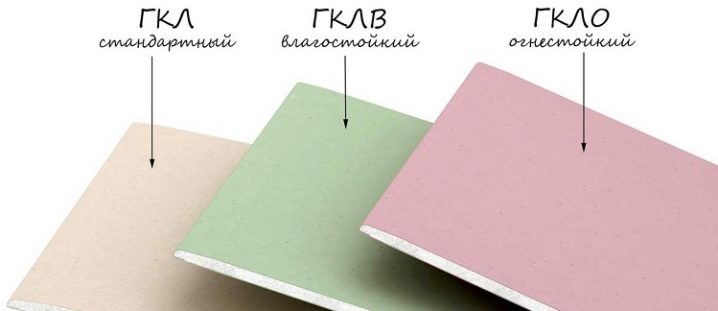
How to measure correctly?
Before you engage in the independent manufacture of an arch (in our case, plasterboard), you should decide on the size of the doorway - its height, length and width. They should be measured as accurately as possible, after which a sketch should be made on paper using a pencil and a compass. The next step is to check the accuracy of the measurements. To do this, it is better to make a paper or cardboard arch - a prototype of the future drywall construction, and try it on the doorway.
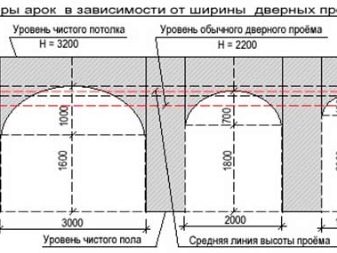
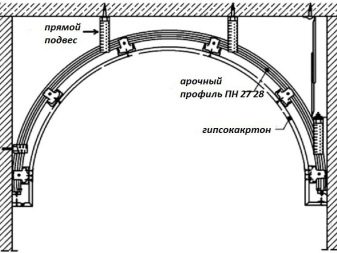
Please note that the dimensions of the doorway are calculated without taking into account the dimensions of the door. Ideally, by this time, the door should already be removed and all damage to the wall should be repaired, which can distort the results of the calculations.
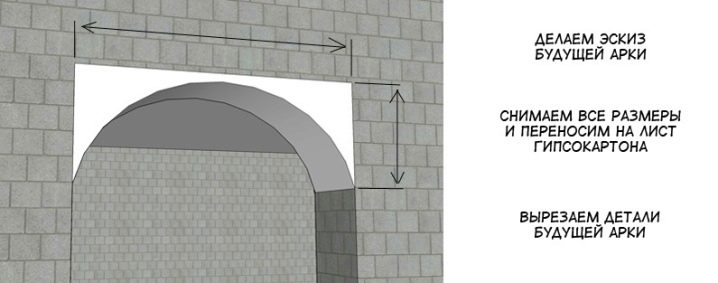
It is advisable to measure the indicators using precise and flexible instruments - a tape measure is better than a ruler. It is not difficult to carry out all the preparatory operations on your own, but maximum accuracy is very important - this will help to correctly calculate the proportions of the future vault, so that when working directly with drywall, overlays do not arise, and subsequently - structural defects.
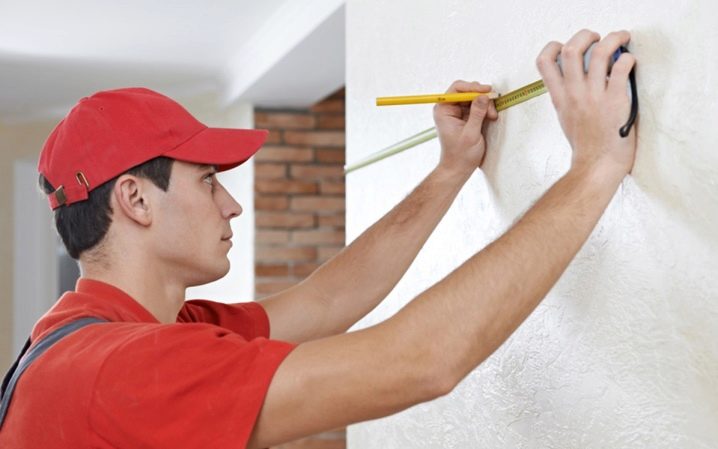
Manufacturing technology
It is quite possible to make an arch from drywall or plywood with your own hands, as well as to sheathe the structure, but this will require certain skills and dexterity, as well as competent step-by-step instructions. Let's consider the main stages of creating a floor.
It is necessary to make a model from drywall based on the measurements made after dismantling the door. It is necessary to make three parts of the future arch - two side surfaces and one arcuate - before bending it, however, of course, will also be rectangular. For the side parts, it is better to use a thicker drywall (up to 12 mm.).
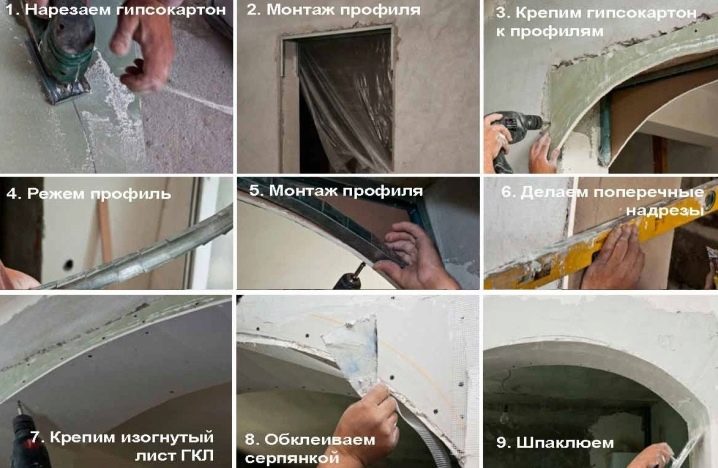
Next, you can start gradually assembling the frame of the future structure. You can also assemble it from wooden elements, MDF. The plasterboard element of the arch itself should be marked out, determining the middle, and attached to the appropriate place in the doorway.
Cutting drywall sheets, taking into account the available dimensions, is best done with a special jigsaw. The resulting rectangular sheet will need to be "rounded" based on the size of the doorway. For this, an impromptu compass is most often used - a nail stuck in the middle of the doorway on a plasterboard sheet. They can safely pierce the surface of the material.
The length of the "compass" should be varied depending on the preferences associated with the shape of the arch. Having outlined the contour, you can make a cutout along it.
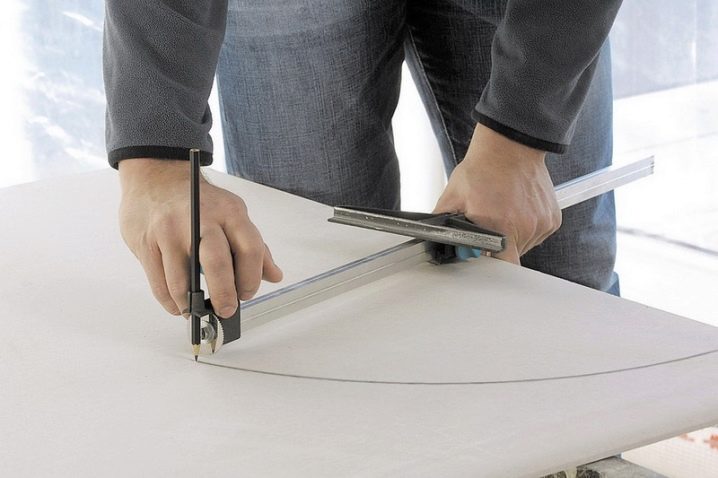
We add that the above assembly operations for maximum accuracy are best performed on the prepared doorway. After dismantling the door, as a rule, you must first putty, repair damage and potholes in the side surfaces. Do not forget to also remove any loose plaster from it.
How to bend the gypsum board correctly?
This stage in the work is the most difficult and responsible. There are two main ways to bend drywall: dry and wet.
Dry technology is suitable for beginners: the sheet (of course, you must first cut it out) should be bent when attaching it. This should be done gradually, without sudden and strong movements, taking into account the thickness of the sheet, which determines the possible bending radius.
To simplify the task (sometimes this method is even considered an alternative), you can make small incisions on the drywall every few millimeters.
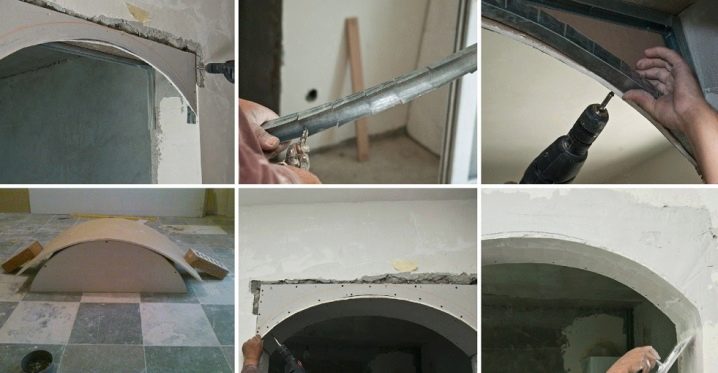
The cuts should be transverse, but not too deep - do not damage the sheet of cardboard. As a result, when fastening in certain areas, the drywall will, as it were, break, which, however, will give the structure a kind of "stepped" specificity. Bending it out with this method will turn out in a more natural way.
The wet method is more complicated, time- and energy-intensive.
It will take almost a day to dry the material alone (at least 12 hours). It is necessary to moisten drywall from the inside, and it is better after perforation with a roller. Wetting is done with a sponge or spray. The essence of this method is that the sheet, over time, under its own weight, will change its shape to the desired one. The angle of leaning such drywall against a vertical wall can vary from 40 to 50 degrees.
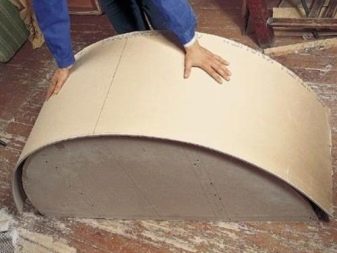
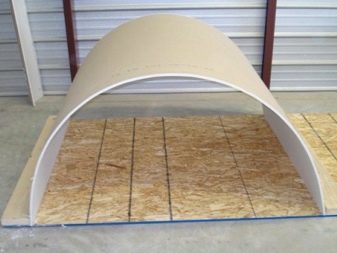
How to install?
After the drywall sheets are ready, you can start assembling the structure. The arch should be installed, fastened to the frame (as an option - metal). Installation of the frame is simple - it can be attached to dowels with self-tapping screws at a distance from the wall, calculated in accordance with the thickness of the drywall sheet. The holes for the fasteners can be drilled with a hammer drill. Depth - up to 6-7 cm.The distance between them is 30-40 cm.
Further, the cut sheets of drywall can be fixed to the frame with self-tapping screws. The main profile must be attached to the walls from the inside and bent (we have already considered how to bend a sheet, and the actions here depend on the method chosen).

Let's add that the bezels on both sides should be the same. If necessary, they can be leveled with a knife or other tools. A slight "drowning" of one of the panels is allowed - it can be eliminated at the stage of decoration. After that, all that remains is to do cosmetic work - putty, painting and others.
Do not forget also that you can put not only a homemade, but also a ready-made purchased structure. The very process of its installation will be essentially the same, but it is important not to confuse anything with the size when buying, and it is better to have a stock of material
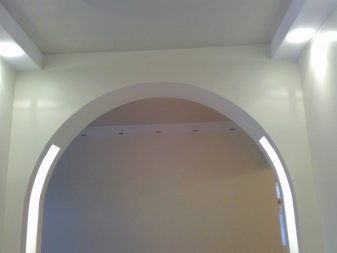
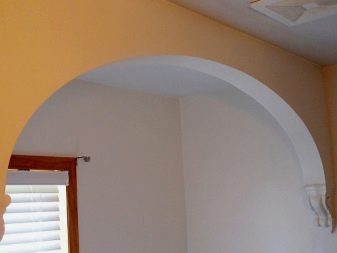
Decor
Installing an arch is not all. But the hardest part is over. What remains is a pleasant and interesting, and most importantly, creative activity - decorating.
There are several ways to decorate a vault:
- Paste over with wallpaper. The simplest and most obvious option, and given the large selection of products, perhaps one of the most varied. Wallpaper can be selected in almost any color and pattern, which means that it will not be difficult to find harmony with the interior (furniture and general style of the premises). Do not forget about photo wallpaper, three-dimensional products - they will give the arch special decorative properties, chic and color, add new contrasts to modern styles.
- Cover with stone. The most expensive, textured option. It is hardly suitable for modern interiors, unless the task is to create a special corner of a large apartment. The stone is perfect for classic interiors and various historical stylizations and improvisations.
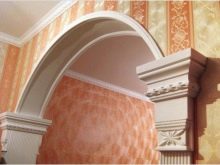
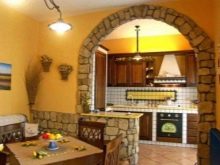
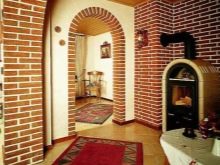
- Painting. You can paint the vault with any paints, including water-based paints (for extra reliability). It will take a little paint, so you can save a lot, or, conversely, buy a small amount of an expensive composition, also not losing much money. In addition, paint allows you to experiment: you can draw ornaments, patterns and decorations solely to your taste.
- Sheathing. Decorating the arch with fabrics is not a new concept, but it is still a very popular concept. You can use a variety of materials - from jute and linen to viscose. It is not difficult to decorate the arches with fabric, but it will give the room an additional sense of coziness.
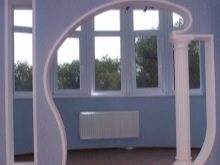

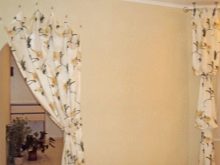
Let's clarify that the decorative framing of the arch should also be practical.Do not forget that the vault is the entrance, that is, the place where they will often walk and, possibly, often carry something through it.
Therefore, the choice of material, be it fabric, wallpaper or paint, should be based on their quality and durability.
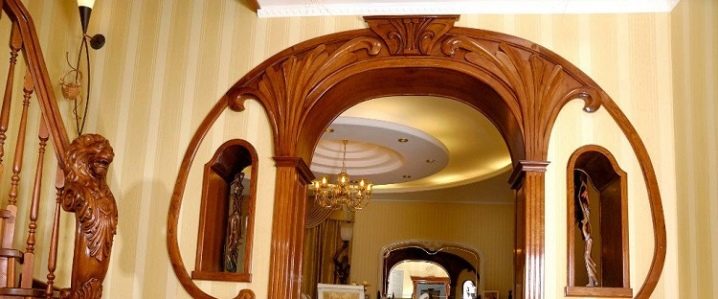
Beautiful ideas in the interior
And finally, let's look at some beautiful options for using arches in various interiors.
In an old-fashioned classic interior, a standard rounded arch will look great. It can be veneered with gray, light stone and painted with paint, as well as matched to the texture of the furniture. This option is especially advantageous if the arch leads to the living room, in which the fireplace is installed. The interior itself can also be decorated in light colors to avoid the connotations of "dark ages". The result will be rich, energetic and stylish, and no one will consider the owner of such an interior to be lagging behind fashion.
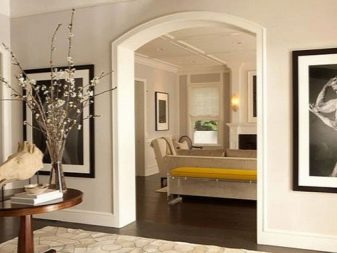
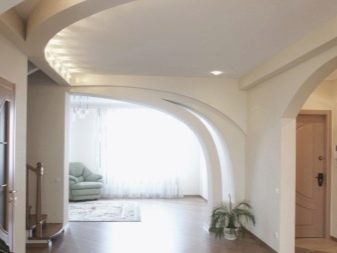
For a modern high-tech interior, an original arch consisting of geometric shapes is perfect. You can use almost any color, vary the colors from light blue to bright purple. Minimalism will emphasize the advantageousness of the composition - in this case, it is better not to clutter up the large free space with furniture.
And one more idea - for the bedroom. At the entrance to it in a small apartment, you can use a semi-arch or a trapezoid. On the one hand, it is very economical, and on the other, it is a stylish option. Using such a design will make the entrance to the bedroom more natural, as well as preserve and even enhance the feeling of comfort, so much needed for a good rest or sleep. In addition, this will also solve the problem of airing the room - there will always be a lot of air in the bedroom.
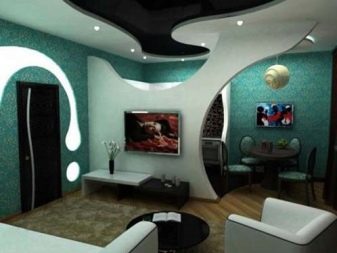
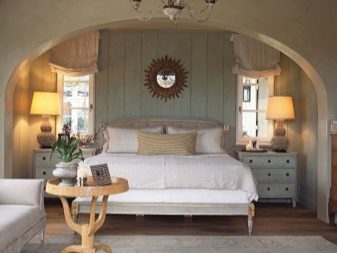
We add that the arches will look good in almost any interior, both in the chamber and in the spacious, the main thing is to pick them up to the place, make and install them with high quality, decorate them beautifully, and then enjoy their aesthetic advantages - airiness and openness.
In this video you will find information on how to make a drywall arch.













The comment was sent successfully.